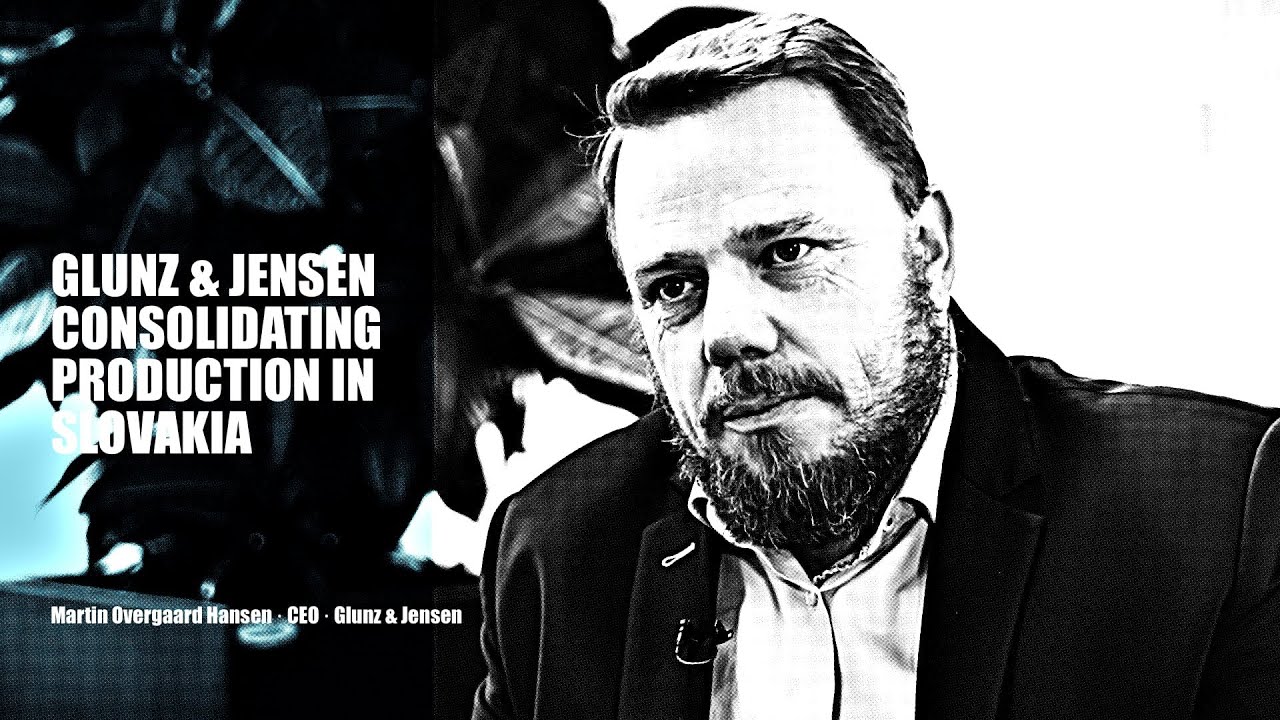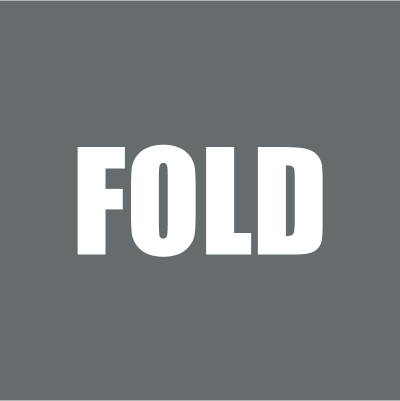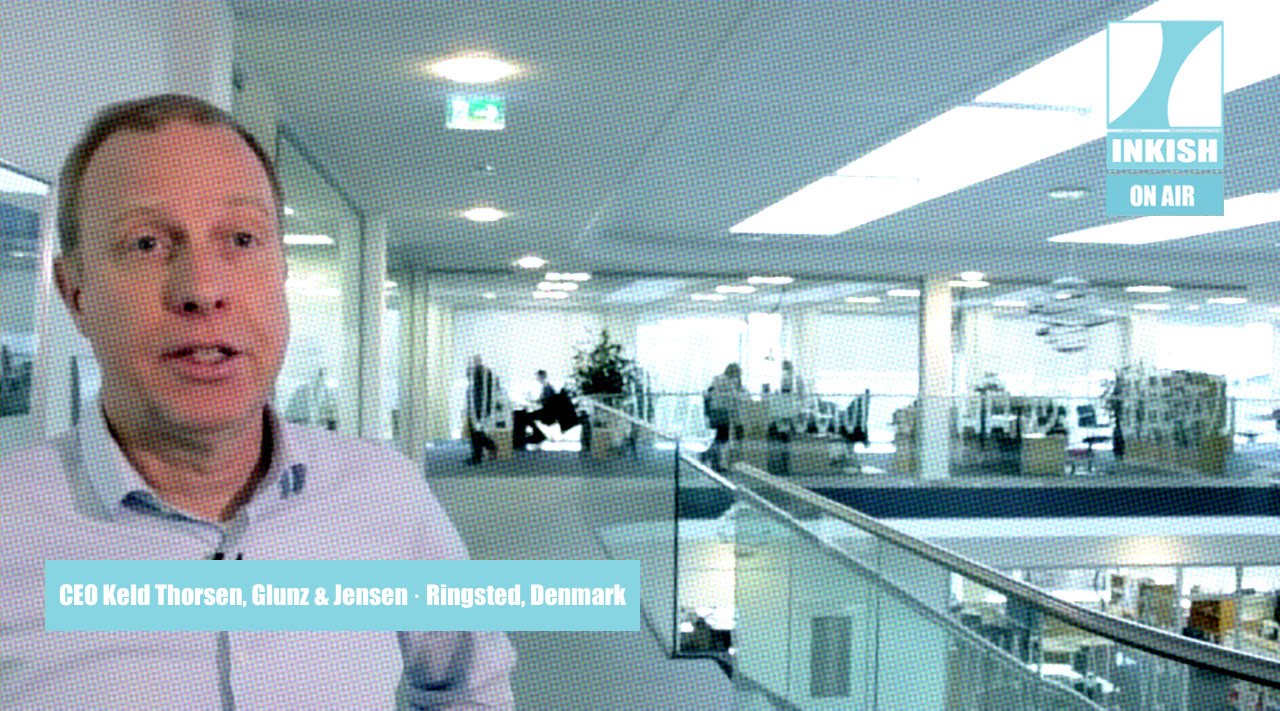Glunz & Jensen consolidating production in Slovakia · Martin Overgaard Hansen · CEO · Glunz & Jensen
Martin Overgaard Hansen is the relatively new CEO of Glunz & Jensen. The company has deep roots in the pre-press industry, producing equipment for high-quality plate-making. With administration and R&D in Denmark and production in Slovakia, the company is in a restructuring mode where the company is scaled to meet the future’s needs. Martin Overgaard Hansen comes from outside the printing industry and has the tough job managing the restructuring.
In this INKISH Conversation, we get a great insight into how the company sees itself and its future role.
Martin Overgaard Hansen. We are here at Glunz & Jensen’s headquarter in Denmark, right? And thank you very much for taking time to see us here from INKISH today. So a pleasure to meet you. We have already had good fun, right?
Absolutely.
Yeah.
Glunz & Jensen is a quiet old company. Can you just bring us up to speed? What is Glunz & Jensen? And what is it you do?
I’ll do my best to do that. And first of all, welcome to Glunz & Jensen. And we are happy to have you here in Nyborg, in Denmark. And as you all know we are a relatively old company that grew up in the offset segment of the graphic industry. And since 10 years or so, we have moved also into flexo, both solvent and thermal. Did a couple of acquisitions of Degraf in Italy and Microflex here from Denmark. So we are now present both in the offset and flexo solvent and flexo thermal parts of the graphic industry.
And you are a relatively new CEO to the company. So tell us a little bit your background and who you are also as a person.
That’s correct. I’ve been working here now since September of 2019. So a little over a year and prior to joining Glunz & Jensen I worked in various different industries. I’m actually an auditor by training. Uh, I don’t think the auditors stand will be so proud of that right now. But I’ve been working with other businesses for almost 20 years. I’ve been working with office furniture, with semiconductors and with heavy rotating equipment. And uh, now I joined Glunz & Jensen a little over a year ago.
And if you look at your business history and we spoke about before the cameras turned on, that this industry is a challenge to many people. Especially if you come from large industries or from other industries. So all the things that you have from your past, is that something that you can use also in relation to your new job?
Absolutely. Uh, for sure. I mean, the graphics industry is pretty segmented, in my opinion. So the offset part has been suffering quite heavily over some years, maybe decades. Uh, because of the reduction in printed magazines, books, newspapers, that kind of stuff. While the flexo segment has been growing, uh, packaging is growing. And this is actually something – we’ve seen an increased growth here during the Covid period that we are currently encountering.
With all due respect – and maybe I’m not right. But the way I always see Glunz & Jensen when you talk about the offset is like – if you look at offset, you have like low volume, mid volume, high volume, and you have different segments in the industry. I think that one of the advantages that I remember Glunz & Jensen made with use of the Epson printhead to use the offset plates using a simple inkjet technology. I think that is still something that you do. But is that when you talk about the decrease in the demand of offset print, is that because that segment has been replaced by, for example, digital? Or is it entirely that segment that is disappearing from your perspective?
As we see it, the the whole offset segment has been shrinking. I mean, I think we are still a strong player in the offset market for sure. Both in the, let’s say, traditional offset equipment, but also what you are referring to with the inkjet technology, so what we refer to as the iCtP. This is still a strong platform for us. We have a pretty significant installed base and we actually are still doing development of machines in the iCtP. So we are launching a new product, more or less as we speak. We have high expectations too. This product is especially good for, let’s say, smaller volume customers in remote locations because it’s a stand alone system. And we are able to supply state of the art technology in that segment and also deliver the consumables for that. So that’s something we still have high expectations from.
And it must be nice because we spoke about that, I think, everybody has during the pandemic experienced a lot of challenges. Both business wise and sales wise, sales and marketing wise. And I think that from that perspective, you have been able to both, manufacture and develop new equipment. You have also been able to consolidate your production facility. Can you talk about that for a second?
Yeah, that’s correct. As I think many other businesses, both in the graphic industry, but also in many other industries. We have had a tough time during the pandemic. But we’ve managed to make the best use of it by consolidating our manufacturing, as you’re rightfully saying. From, previously we had manufacturing both in Denmark and in Slovakia. And we’ve now consolidated all our manufacturing in our facility in Slovakia, which is our own facility. So it’s been there for 15 years. Previously, it was making mainly offset, then we transferred to flexo solvent. And during the pandemic, we also transferred our thermal flexo activities there. So we now completely consolidated our entire manufacturing and also spare parts pick, pack and ship in Slovakia. So we have a shorter time to market and we also have a much more lean and efficient setup. So that’s been as I said – I think we make good use of a critical situation.
And in the pandemic, did you all have any opportunities to go to Slovakia to lead this process? Or you just had to look at that from an iPad or something like that?
We used a lot of new technology, so to speak. But we also managed to get there a couple of times. I’m a big believer still in meeting people in person and following activities. So as you’re probably more aware than I, it’s not easy to travel these days. But with a little hiccups here and there, we managed to get there a couple of times over the last six to nine months.
I remember because I spoke to you at one of your predecessors many years ago. Just when we started, I think it was maybe one of the first 10 interviews we did was with your predecessor Keld Thorsen I think his name was. And I think that was after the establishment of Slovakia was still recently new. And your operation there now is capable of handling all your technologies. How is it to manage a company from Denmark? And then, you know, that production. And do you also do some R&D in Slovakia?
Yes we also do R&D there. We still have R&D in Denmark. But we also have some R&D people in Slovakia. It is managing on the distance. It’s a little bit of discipline on its own. Luckily I had many years of experience with that. And I think that as with many things in life, it all depends on people on both sides. So we are lucky. We have a good and well trained staff in Slovakia. And we also recently hired a Slovakian CEO who is taking care of all the manufacturing. That is different of how it was in the past. We now have, that’s probably not the right way to say it, but we have a pull from Slovakia to get more work, so to speak. Whereas in the past we had more of a push strategy.
The Danish organization was pushing everything. They have to do this, but we keep this. Whereas now we have it the other way around. The Slovakians are saying: why can’t we have that and that and that also?
So does that mean also that the functions you have here in Denmark is more like servicing everything that you do in Slovakia also?
I think that will be the end result. Yeah. Right now – as I said, part of the management is still in Denmark. We have some very skilled backoffice people here. Installation people. We have finance functions here and we have R&D for certain segments. But all the rest is now in Slovakia.
Regardless of how great this sounds. It’s also a fact that, you know, the entire world is changing. A lot of people talking about moving into digital technologies. And how do you see Glunz & Jensen’s role in the future? Market for both – for the label packaging flexo and for offset? How do you see your role in this future?
I mean, I don’t think anybody and for sure not myself are able to predict what new normal is going to look like in the industry after…
But you have to make some decisions, right?
Exactly. And we are making decisions for sure. But whatever market is left, we still believe firmly that we will be a strong player in those markets. And of course, the digital print is somehow pushing into our field of competence. On the other hand, what we’re still seeing and hearing from a lot of customers is that they want to stick to the, let’s say, traditional technology.
So you basically see this as an opportunity to have both the analog version and the analog production side by side with electronic and digital production. And that’s where you also see a role for Glunz & Jensen in the nearby future?
Absolutely.
And I can’t help thinking about because as I remember from the past. And maybe I’m not 100 percent up to date – but I remember you were extremely successful. For example, in the American market where you have a lot of smaller printers still doing like one, two, three, four, calls offset in small print runs. Is that still a market that you address?
Yes, we still address the North American market. I think what we if I we look…
I was not thinking just about the North American market, but also the smaller segment in the market. Or where do you see your role?
Yes, we addressed that for sure. Our distribution channels are. We are addressing some of the -what you’re saying – the smaller customers via deals. And then we obviously work with the major OEMs as well. I think if you look historically at the constant deals and performance. We’ve been very strong in Europe and in North America. And we’ve had less focus on Asia and Latin America. And this is some of the things we’re looking at right now. Because these markets are at least percentage wise, growing faster than the traditional markets in Europe and North America. So we are trying to refocus our sales efforts so we get a more balanced approach to the markets where there is still growth.
And how difficult is that?
I can tell you when we find out if we succeed or not. But of course, it’s not easy. But on the other hand, I think focus makes a big difference here. And for sure, in the past we have not had a huge focus on those segments. I can also mention that we’ve just hired a new chief commercial officer Massimiliano Merlo who is coming from one of our competitors. And he will hopefully push these tasks even harder. So I’m comfortable that we will succeed and still be a strong player in the markets that we are present. Also after the pandemic. What is difficult to say is how will the markets look? So I kind of put a number on how are we going to perform? I can say that we will be there and will be strong.
Some of the things I’ve been talking to a lot of people about during the pandemic is also that the pandemic seems to have changed focus from printers to move ahead in the maybe digitalization curve faster than anticipated. Is that something that you feel? Because I mean, you are addressing some of the markets that could be digital. Right? So I was just wondering if that is something you see as a challenge also in that perspective of making sure that you get your products to market?
It’s definitely a potential challenge. We haven’t seen so much of it yet. To be honest with you, most of our customers, they’re still loyal to the strategy – sorry I mean to the products that we are providing them with. So what we’ve seen so far is more that the short market has shrunk. Not so much that we have been…that it has been cannibalized by the digital print. Of course, the players in digital they are big.
They try to take everything they can, right?
Exactly. They are big and they’re pushing hard. So it’s definitely something that we are watching carefully.
Your business is that both machinery and consumables?
It’s machinery for the most part. We’re doing consumables primarily for the iCtP segment that we that we talked about a little earlier.
Yeah. So when you look during the pandemic, I mean… I could imagine that maybe the consumables is maybe steady or maybe even growing. And I could imagine that maybe the machine sales is a little bit less than normal. Is that something that you think can, you know, change the perspective of where you see your business also in the future?
I think your imagination is right. But I’m hopeful that what we’re seeing right now, the slowdown that we’re seeing in the equipment business is mainly related to the uncertainty there is in the market. That’s one point. And the other point is that a lot of our customers in the flexo industry have been very busy selling plates. So they’ve not been basically looking at new equipment. Hopefully we will see that the plate consumption stabilizes so that we will then see, let’s say a pickup in the equipment business. When the pandemic hopefully is beyond us.
You know what I thought you would answer? I would say that it is because there was no DRUPA and Glunz & Jensen is known for DRUPA for your Jazz Band…
And our sausages.
And your sausages. So I thought that was the main reason. But that was not the case.
We can still provide a sausage to customers. Drop by in Denmark. So that’s not an issue. But when you mentioned DRUPA, it could be… As I said before, I’m new to the industry, so I’m not really the right guy to ask for the DRUPA.
But you knew the about the Jazz Band?
I knew about it, I have been told about the jazz band and also about the sausages.
But I think what… At least the industries I worked in before, we’ve seen a less and less impact of these trade shows because most companies, when they are ready to launch a new product or they want to buy equipment. They do not want to wait for four years for launching or buying. So I think the dynamic in the whole world has been changing over the last decades. Of course, as I said, I cannot talk specifically to DRUPA. But I think in general terms trade shows is something that we will see less of in the future than we have seen in the past.
So what replaces it from the Glunz & Jensen perspective? Is it that you have like showrooms or is it virtual or do you go to customers? How do you…?
We go to customers. We expect to build a showroom in Slovakia when we are fully up and runnning there. But we also use a lot…bringing customers to…to some of our current customers. Because I think it’s very important, not not only for us, but also for the customers to talk to like-minded people. To hear how is the Glunz & Jensen equipment working? What’s the pros and what’s the cons? If any. I can only imagine very, very few. But it’s just a different dynamic that you get from bringing a customer to a happy customer than sitting at a trade show and drinking beers or champagne and telling the customers that: Yes, of course, it works. It gives a different feel when you know for real.
And, you know, it’s kind of funny because I can’t help thinking of that. At the last DRUPA where you were not there. And I think that most people recognize what I’m saying now. The Glunz & Jensen booth has always been extremely busy at the trade shows. So even if you wanted to have a demo or talk to a representative, it might even be more difficult because it’s such a dense time of showing equipment. So maybe the strategy will give you even more advantages by, you know, having the time and, you know, own the customer for that moment of time where you can tell them the stories about your thing. Is in general, just maybe it is a stupid question. But I ask anyway. When you look at your customers, do you find that they are successful also due to the technologies that you deliver?
Absolutely. The customer base we have is generally very happy and very satisfied with our equipment. And some of the launches we’ve done here recently are also providing enhancing, more efficient, more efficiency with the customers. I think that’s definitely a strong selling point of the Glunz & Jensen equipment. I mean, we are going to be a high end equipment manufacturer. So we’re definitely not the cheapest. But we are delivering cutting edge technology and good quality.
And you have… I think that also most people recognize that you have also not just been cutting edge, but you have also been innovative in a lot of areas. With this one, we spoke about before that sometimes you see maybe not just from Glunz & Jensen, but in all industries, you see somebody copying maybe a little bit too much technology. Is that something that you see in your segment as well or are you kind of exclusive in where you are?
Of course, we are trying to keep our eyepiece tight but I think at least compared to other industries I worked in, there seems to be, let’s say, a pretty open approach here to getting good ideas from each other.
And so when you get new ideas, the best thing you can do is basically protecting them by patents or figuring out how to do things that are more complicated to copy?
That’s one option. I think what we also are proud of is that we believe that we deliver the best quality. Yeah. So one thing is that you may have the same functionality, but how long will it last? How many breakdowns will you have on that kind of stuff? So we still preserve the Glunz & Jensen name as a high end equipment manufacturer. And this is something that we… That’s our DNA.
Yeah. And I think that also, as far as I remember, maybe I don’t know if it has changed… But I think that you have always been a very well recognized also for your service globally, right?
Yes, I believe so. And this is also a focus of ours to make sure that we… That we make sure our customers, our service of course… The current travel restrictions may have caused some hiccups in that. I think not only for Glunz & Jensen but in general. Yeah. But we have a pretty broad service network. So I’m hopeful that our customers are happy with the service they’re getting from us for sure.
Being still a relatively new CEO of Glunz & Jensen. What is your perspective of your role in the future? And I know that we’ve been talking a lot about equipment and how you see the market. But I was thinking that I would assume that every time you have a new CEO of a company and of course, as being on a public company and also having a board that you have to… And you have like a big owner, is it Helio Group?
Heliograph yeah.
Heliograph yes. From your chair…is that, what is the perspective of your business?
That’s a big question.
I’m sorry to ask that.
No, no, it’s fine. But I think… So first of all, I mean, since I joined we’ve been in a critical situation. First of all, because we’ve been transforming from offset into flexo.
So you took the Corona along with you, right?
Yes. I brought the Corona. No… Then we were hit by the Corona and by no means that should be a bad excuse. But I think the circumstances made life a little, a little challenging for us here over the summer. And as I said before, we’ve tried to make the best of the crisis. And fixed our internal issues, consolidated our manufacturing and that kind of tasks. And now with our new chief commercial officer, we’re looking more outside the company. We’re looking for new opportunities, as I’m saying. As I said, we are launching the new iCtP product. We’re looking at new markets. So we’re hopeful and comfortable that we will have a bright future ahead of us.
Thank you very much Martin.
Thank you. Pleasure having you here. And I look forward to seeing more good stuff from you guys.









































































